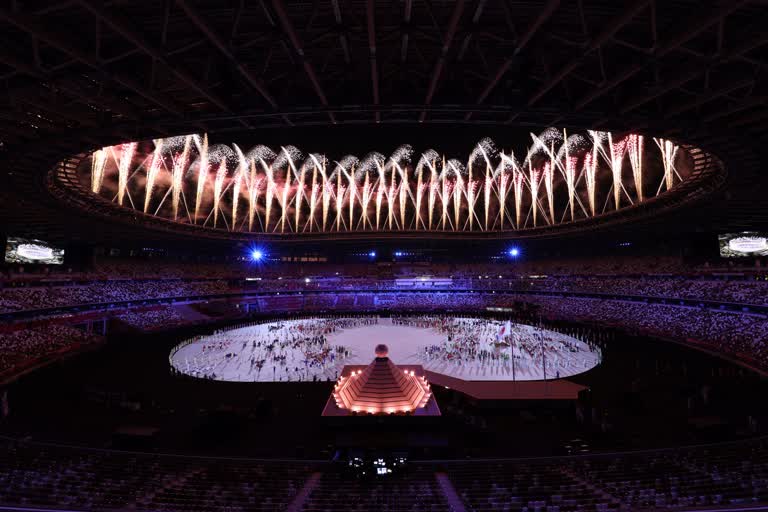Tokyo: Applying high-end technologies, including virtual and augmented reality, and merging that with traditional Japanese motifs, the organising committee of the Tokyo 2020 Olympic Games put together an opening ceremony that lacked the glitz and glamour of previous editions but was apt for the current situation of a world ravaged by the Coronavirus pandemic.
The usual razzmatazz and razzle-dazzle and pyrotechnic caused by laser and high-intensity sound were replaced by the clever interplay of light, sound, and shadows with softer music.
Also Read: Pandemic-hit Tokyo Olympics kicks off with opening ceremony
Postponed by one year due to the pandemic, the Tokyo 2020 Olympic Games finally opened on Friday night at Tokyo's Olympic Stadium behind closed doors, adding a new chapter in the history of the Olympic Games.
Led by six-time world champion and London Olympic bronze medallist boxer MC Mary Kom and men's hockey team captain Manpreet Singh, the Indian contingent made a subdued entry, as the 21st group in the march past, with less than 30 representing the full contingent of over 200.
There was no cheering, screaming, and clapping by the huge crowd that usually fills the stadium for ceremonies of this magnitude and stature because the fans are banned from the entire Olympics. However, the athletes did not seem to mind as they got ready to represent their respective countries.
The biggest sporting event on the planet is being held exactly one year later than originally planned due to the postponement caused by the Covid-19 pandemic.
Only about 950 people, including officials and reporters, were allowed into the 68,000-capacity venue to watch the opening ceremony. But perhaps for the first time in Olympic history, billions of the audience members enjoyed the show more than the very limited number of Olympic family members present in the stadium.
It has been almost eight years since Japanese people celebrated the return of the Olympic Games after the 1964 Olympics, but the journey to this point was full of challenges.
On March 24, 2020, Japan's then Prime Minister Shinzo Abe and International Olympic Committee (IOC) president Thomas Bach agreed to delay the Tokyo Olympics and Paralympics by one year due to Covid-19, four days after the Olympic flame, which was lit up in Olympia, Greece without spectators, arrived in Japan.
Sixteen months later, the coronavirus is still threatening the Games, with Tokyo put under its fourth state of emergency for the duration of the entire Olympic Games. On Thursday, Tokyo 2020 organisers reported 12 new positive Covid-19 cases related to the Olympics, including two infected foreign athletes in the athletes' village, bringing the total number of Olympics-linked cases to 87 since July 1.
Consequently, the majority of the venues barred spectators from entering, with cheers and chants from previous Games to be put in place as part of the IOC's digital engagement campaign to ensure athletes won't feel alone.
It wasn't until late Thursday night that the organisers confirmed the opening ceremony would stick to its original programs following the firing of ceremony director Kentaro Kobayashi after a joke about the Holocaust he made in 1998 resurfaced.
Also Read: Tokyo Olympics: Mary Kom, Manpreet lead India's charge in Parade of Nations during Opening Ceremony
Yet, against all odds, a virtual seed under the surface of the Olympic Stadium sprouted out of the ground after intensive struggles displayed by its human representation inside the arena, starting a countdown that led to the eventual start of the spectacle.
IOC president Thomas Bach said earlier at a press conference that the Olympic Games are capable of "getting the entire world together in one peaceful competition, to have athletes in one country, in one city, in one Olympic village, competing against each other but living together because they are under the same rules."
The Tokyo Olympic Games, attracting 11,000 athletes from 206 delegations and the refugee team, will run through August 8.
IANS



